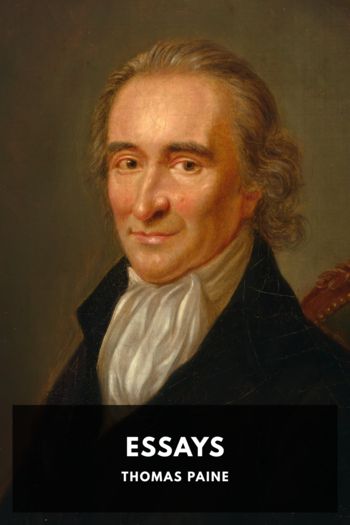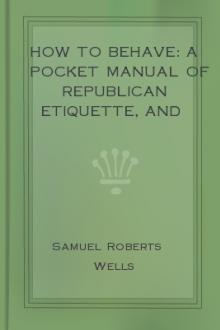Essays by Thomas Paine (black books to read .TXT) 📕

- Author: Thomas Paine
Book online «Essays by Thomas Paine (black books to read .TXT) 📕». Author Thomas Paine
—Conway ↩
The Boston Investigator’s compilation of Paine’s Works contains the following “as supposed to be Mr. Paine’s”:
“Royal Pedigree.—George the Third, who was the grandson of George the Second, who was the son of George the First, who was the son of the Princess Sophia, who was the cousin of Anne, who was the sister of William and Mary, who were the daughter and son-in-law of James the Second, who was the son of Charles the First, who was a traitor to his country and decapitated as such, who was the son of James the First, who was the son of Mary, who was the sister of Edward the Sixth, who was the son of Henry the Eighth, who was the cold-blooded murderer of his wives, and the promoter of the Protestant religion, who was the son of Henry the Seventh, who slew Richard the Third, who smothered his nephew Edward the Fifth, who was the son of Edward the Fourth, who with bloody Richard slew Henry the Sixth, who succeeded Henry the Fifth, who was the son of Henry the Fourth, who was the cousin of Richard the Second, who was the son of Edward the Third, who was the son of Richard the Second, who was the son of Edward the First, who was the son of Henry the Third, who was the son of John, who was the brother of Richard the First, who was the son of Henry the Second, who was the son of Matilda, who was the daughter of Henry the First, who was the brother of William Rufus, who was the son of William the Conqueror, who was the son of a whore.”
—Conway ↩
J. J. Rousseau, Contrat Social. ↩
See the first year of La Feuille Villageoise, No. 42.28 ↩
The reader should bear in mind that this phrase, now used vaguely, had for Paine and his political school a special significance; it implied a fundamental Declaration of individual rights, of supreme force and authority, invasion which, either by legislatures, law courts, majorities, or administrators, was to be regarded as the worst treason and despotism. —Conway ↩
See No. 50. ↩
In his appeal from prison to the Convention (August 7, 1794) Paine states that he had, as a member of the Committee for framing the Constitution, prepared a Plan, which was in the hands of Barère, also of that Committee. I have not yet succeeded in finding Paine’s Constitution, but it is certain that the work of framing the Constitution of 1793 was mainly entrusted to Paine and Condorcet. Dr. John Moore, in his work on the French Revolution, describes the two at their work; and it is asserted that he “assisted in drawing up the French Declaration of Rights,” by “Juvencus,” author of an able “Essay on the Life and Genius of Thomas Paine,” whose information came from a personal friend of Paine. (Aphorisms, Opinions, and Reflections of Thomas Paine, etc., London, 1826. Pp. 3, 14.) A translation of the Declaration and Constitution appeared in England (Debrett, Picadilly, 1793), but with some faults. The present translation is from Œuvres Complètes de Condorcet, tome xviii. The Committee reported their Constitution February 15th, and April 15th was set for its discussion, Robespierre then demanded separate discussion of the Declaration of Rights, to which he objected that it made no mention of the Supreme Being, and that its extreme principles of freedom would shield illicit traffic. Paine and Jefferson were troubled that the United States Constitution contained no Declaration of Rights, it being a fundamental principle in Paine’s theory of government that such a Declaration was the main safeguard of the individual against the despotism of numbers. —Conway ↩
Printed from the first edition, whose title is as above, with the addition: “By Thomas Paine, Author of Common Sense; Rights of Man; Age of Reason. Paris, Printed at the English Press, rue de Vaugerard, No. 970. Third year of the French Republic.” The pamphlet seems to have appeared early in July (perhaps the Fourth), 1795, and was meant to influence the decision of the National Convention on the Constitution then under discussion. This Constitution, adopted September 23rd, presently swept away by Napoleon, contained some features which appeared to Paine reactionary. Those to which he most objected are quoted by him in his speech in the Convention, which is bound up in the same pamphlet, and follows this “Dissertation” in the present volume. In the Constitution as adopted Paine’s preference for a plural Executive was established, and though the bicameral organization (the Council of Five Hundred and the Council of Ancients) was not such as he desired, his chief objection was based on his principle of manhood suffrage. But in regard to this see Paine’s “Dissertations on Government,” written nine years before, where he indicates the method of restraining the despotism of numbers. —Conway ↩
“The Bill of Rights (temp. William III) shows that the Lords and Commons met not in Parliament but in convention, that they declared against James II, and in favour of William III. The latter was accepted as sovereign, and, when monarch. Acts of Parliament were passed confirming what had been done.”
—Joseph Fisher in Notes and Queries (London), May 2, 1874This does not affect Paine’s argument, as a Convention could have no more right to bind the future than a Parliament. —Conway ↩
“The sacred rights of mankind are not to be rummaged for among old parchments or musty records. They are written as with a sunbeam in the whole volume of human nature by the hand of Divinity itself, and can never be erased or obscured by mortal power.”
—Alexander Hamilton, 1775(Cf. Rights of Man, vol. ii,





Comments (0)